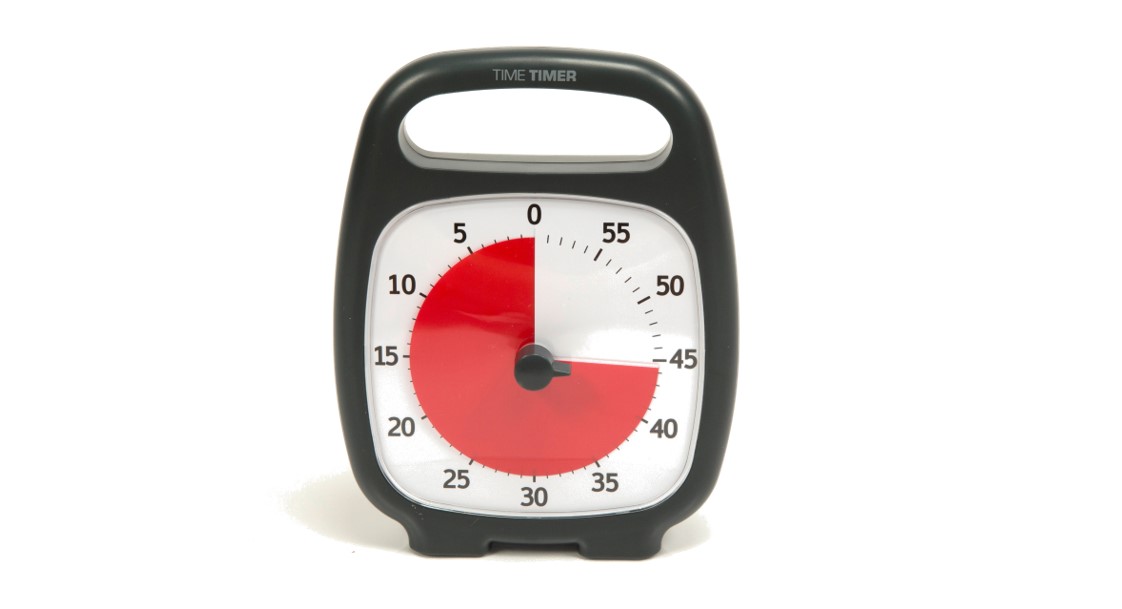Time is an abstract concept that a child acquires gradually during early childhood. Concepts of time are among the most difficult concepts to grasp for a number of children with special needs because they are very abstract. This lack of understanding “time” can be a very strong source of anxiety; suggesting the need to stimulate the acquisition of this concept.
Stages of development
Although the concept of time begins to take form shortly before the age of 2 years old, it is only in the period of 11-12 years of age (Piaget) that the essence and feel of time becomes truly integrated.
Before the age of 2, a child becomes increasingly aware of the idea of succession and sequence as he begins to perceive events having a beginning and an end, as well as being organized in a sequence. For example, “my meal begins when the bowl is full and ends when my bowl is empty; I always take a nap after my meal.”
Between 2 and 3 years, a child becomes increasingly aware of the movement of time and begins to develop notions of past, present and future. “There was a time that came and went and a there is a time that is not there yet, but is coming.” It is this understanding that enables him to understand the concept of ‘waiting’ and therfore better tolerate delays.
At approximately 3 years old, the knowledge a child acquires about time during early childhood becomes more obvious when he begins to understand and experiment with vocabulary related to time. However, at this stage he still confuses the words and the realities these represent.
Understanding the concept of duration, a time interval that can be measured, arrives closer to 5-6 years. A child becomes familiar with events and actions that display a regularity (ex. Christmas, hour, day of week, month, season, etc.) and also develops an interest in observing and using measuring instruments such as calendars and clocks, despite the difficulty understanding these tools.
The notion of planning a schedule or task will come later at about 8 years old. The child will eventually also become aware that he has the ability to adjust the speed at which he does things according to the available time (ex. hurrying to accomplish the morning routine so not to miss the bus to school); but this ability will take several years of refinement before meeting adults’ expectations.
Stimulation Activities
Listed below are stimulation activities that are appropriate for each stage according to a child’s individual needs.
1. Concept of succession and sequence:
Activities that contain a physical component that marks the beginning and the end of the activity : for example, the game comes in a basket, starts, and then returns to the basket when it is finished.
Activities that contain a verbal component or indicator of its beginning and end : one song announces the beginning and another the end of the activity including storage of the pieces. “Clean up, clean up….”
Interactive games that require anticipation of actions : I will run after you and when I catch you I will tickle you.
Obstacle courses.
Images to be put in order according to their appropriate sequence.
Simple, illustrated recipes : toast the bread, spread a topping on the toasted bread, cut the toasted bread.
Seriation activities with a model : bead a necklace from a preset color sequence card.
Follow a visual schedule with pictures .
Repetitive nursery rhymes and songs.
Magic formula with a predictable result (ex. Abracadabra, he comes the bunny!).
2. Notion of past, present and future
Look at photos or watch videos of recently experienced activities : videotape the family having dinner and watch the recording after the dinner is finished.
Taking turns in games where the rotation between turns is fast : taking turns dropping a ball into a roll of empty wrapping paper.
Having a child describe to you what they did or what happened to them so far in the day and then having them try to describe to you what they believe will happen later on in the day (anticipation).
Observe over days the growth of a plant (ex. bean placed on a wet paper towel in a jar sprouting) or food, that grows or ripens fast (banana changing color, potatoe sprouting, apple turning brown).
Analyse and compare photographs and/or videos focusing on a single person (parent or child) in different temporal instances :
Mom as a child, mom as a teen, mom as an adult
The child’s Christmas at 2, 3 and 4 years
The house kitchen over three different stages of renovation over a time period of many years.
3. Concept of duration and interval
Practice measuring the duration of different activities using “concrete indicators” that visually support and show the passing of time. For toddlers or children who are having additional difficulty with the concept of time, the stronger the concrete visual, the easier the concept will be to grasp. Give the child the opportunity to ‘see’ the time pass in creative ways to make learning even more appealing.
o Fill a container with objects such as balls or blocs : When the jar is full, you can ….
o Replace the numbers and hands on a clock with images or pictures and use the hands as visual markers : When the caterpillar is on the lion, you will have to get dressed .
o Choose a type of music or a series of songs on a CD (always the same ones) so as to allow anticipation of the end : When the music ends, you must leave the bath.
o Give the child a number card and let them follow as you count : follow with your finger; When I reach 50, you must turn off the TV.
o Draw a time strip and gradually color in the trail as time passes. This method is ideal during car trips, but applicable in a variety of contexts by adapting the drawings : When the strip is fully colored we will arrive home.
o Numeral strip: A blank strip with velcro attached to the front is given to a child and an adult hands them a number (velcro attached on the back of each number) that can be placed on the blank strip as time progresses according to the rhythm of the adult : Mommy will hang up the phone and play with you when you have received the 5 digits. o Commercial sand timers with varying durations exist. These sand timers are a very good “concrete” visual tools as they physically demonstrate the passing of time as the sand falls down and they can make thinking about time fun and interesting : Let’s try to get dressed with the pink timer today (2 min).
o Commercial visual timers are also useful for many children : When there is no more red, it is going to be time to start your homework. These differ from sand timers as the child is not able to actually see time pass by in very small increments but the red is a strong visual indicator that is easily referenced.
4. Notion of recurring time:
Make different tools representing the cyclical succession of time : a wheel that represents the day, week, year … with amarker (a paper clip or clothespin) that can be moved.
Establish various rituals to reinforce the concept of time that you are interested in:
Using a “cou-cou” clock to attract attention to the changing of hours
Using a daily calendar to locate the day before breakfast by circling the number; mark the end of the day before bed with an X on the circle or by coloring the circle to show that the day has been completed.
Having a silly ceremony for the change of a specific season. For example, run around the house in a bathing suit and eating watermelon for the beginning of the summer.
Use vocabulary related to time measurement regularly and with emphasis : hours, seasons, months, etc.
Use a yearly calendar to place all special events of the year (birthdays, holidays etc.) and keep it on the wall all year long to allow anticipation.
5. Notion of planning and adjusting to time constraints
Create a play schedule or a meal schedule with your child (a sequence of games to be played or of meals to be made).
Make changes in a child`s daily routine as a fun event : bathing, brushing teeth, reading a book and then dinner. Talk with the child about the new sequence and the effects of the new sequence. …Is it right to brush our teeth before we eat dinner?
Have fun together trying to do a given activity at different speeds : coloring the same picture slow, coloring the same picture medium, coloring the same picture fast and then comparing the results with the child. Have them point out the differences. Have them choose which one was done slow, fast, etc.
Move at a pace set by a metronome or a hand clapping rythm. Have fun varying the tempo.
Dance to music together; have the child point out differences in the tempo or speed between the songs by asking them pertinent questions about which one is faster or slower.
Try using these various tools to help your child develop not only the concept of time, but a stronger understanding of how time is used in daily activities. Once the child is able to grasp a basic understanding of time as it relates to their daily routines, build on this by exploring different uses of time for more complex activities outside of their daily routines through discussion. You can explain to your child your own routines and the time it takes for you to accomplish your own tasks. You will find that your child will be very interested in what you do and this will also also help to lay the foundation for teaching your child the importance and respect for other people’s time.
Josiane Caron Santha, erg. – Ergothérapie Les Mille-Pattes – www.ergomp.com



Leave A Comment